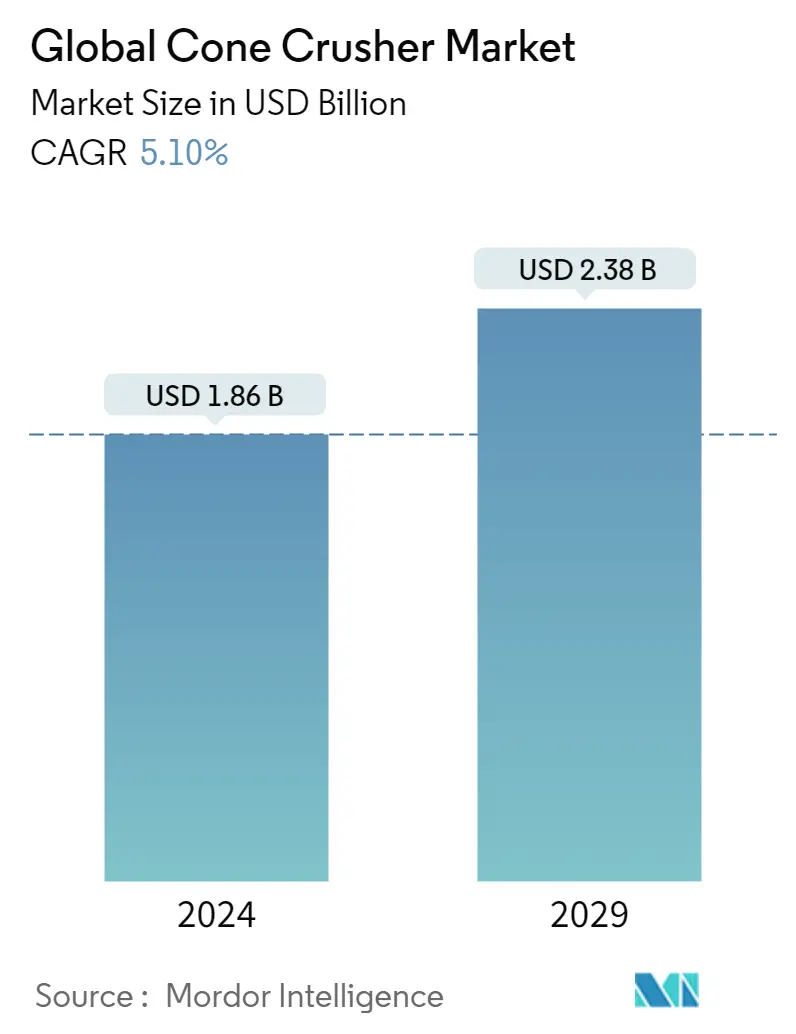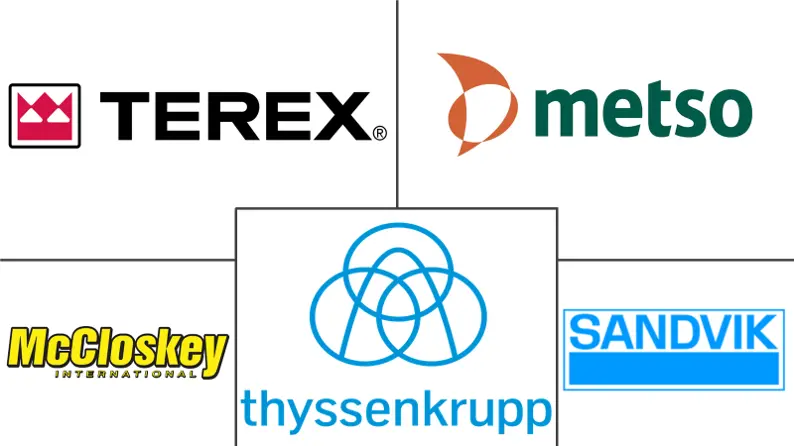Market Size of Global Cone Crusher Industry

| Study Period | 2019 - 2029 |
| Market Size (2024) | USD 1.86 Billion |
| Market Size (2029) | USD 2.38 Billion |
| CAGR (2024 - 2029) | 5.10 % |
| Fastest Growing Market | Asia Pacific |
| Largest Market | Asia Pacific |
| Market Concentration | Medium |
Major Players
*Disclaimer: Major Players sorted in no particular order |
Cone Crusher Market Analysis
The Global Cone Crusher Market size is estimated at USD 1.86 billion in 2024, and is expected to reach USD 2.38 billion by 2029, growing at a CAGR of 5.10% during the forecast period (2024-2029).
The crushing and grinding requirement of industries, such as mining, construction, processing, and demolition, changed drastically in the last two decades, where crushers were primarily stationary equipment that was used to convert coarse materials to more elegant materials, and eventually, pass them onto the tertiary crushing equipment. Nowadays, the demand for mobile and portable crushers is observing significant growth.
- Industries that operate crushing equipment are focusing on lowering costs, increasing production, and becoming more energy-efficient, as crushing equipment is a primary reason behind increased energy consumption in these industries. For instance, ammunition consumes the most significant part of the energy used in mining operations, of about 30-70%. According to Thermo Fisher, grinding and crushing of ore are energy-intensive and account for about 3-5% of the world's power usage. Owing to this, various vendors in the market are increasingly offering solutions that are energy efficient and save costs. For example, Metso's new Lokotrack LT4MX mobile cone crusher is said to provide excellent energy efficiency with the direct v-belt drive.
- New cone crushers that operate with hydraulic hold-down clamping enable industries to crush at a higher capacity with increased power than ever before. The automatic control of cone crushers has maximized power draw and their throughput, owing to which vendors in the market are focusing on increasing the capacity of their offerings. For example, the Nordberg HP900 series cone crusher from Metso comes with a new lubrication system, improved kinematics, a raised pivot point, and increased power to offer a 15% increase in its capacity. The increased size provides increased production and output in the mining industries, where production capacity and throughput are vital.
- The application of cone crushers in construction work and road laying material is significantly rising. With the growing concept of recycling, current crushers can separate bitumen and aggregates for reuse as new asphalt. New asphalt stations can create a unique asphalt mix with up to 70% recycled material, and various businesses are deploying cone crushers, along with jaw crushers, to enhance the speed and capacity. For example, Veljekset Paupek, based in Tornio, Finland, adopted the Lokotrack LT200HP cone crusher and the Lokotrack LT106 jaw crushing plant to create a two-stage crushing process. This enabled it to crush an entire batch of 10,000 metric tons in just two weeks.
- In addition to this, the recent outbreak of COVID-19 significantly restricted the global mining and construction operations, with the industry facing a severe shortage of workforce and capital investment. Such developments are expected to influence the global demand for equipment in these industries, as enterprises are expected to either avoid or postpone their buying decisions during the year. Over the next two years, the mining and construction industries are expected to adopt a larger scale of automation to reduce the dependency on the workforce. Such developments may attract higher investment in cone crushers that are mobile and offer automated solutions. Overall, the demand is expected to rise during the forecast period.
Cone Crusher Industry Segmentation
A cone crusher operates on a compression type of mechanism that reduces material by compressing and squeezing the feed material between a moving and a stationary piece of steel. Final sizing and reduction are determined via the closed side setting or the gap between the two crushing members at the lowest point. Cone crushers are suited for secondary, tertiary, and quaternary applications. The market segmentation by end-users includes mining and metallurgy, construction, and aggregate processing. The scope for the construction is limited to infrastructure, and it covers infrastructure projects, such as railways. The market estimates are based on the statistical approach considering the segments being mutually exclusive and all-inclusive.
The Global Cone Crusher Market is Segmented by Type (Symons, Hydraulics, and Gyratory), Offering (Mobile Crusher, Portable Crusher, and Stationary Crusher), Power Source (Electric Connection, Diesel Connection, and Dual Connection), End-user Application (Mining and Metallurgy, Aggregate Processing, Construction, and Demolition), and Geography.
| Type | |
| Symons | |
| Hydraulics | |
| Gyratory | |
| Other Types |
| Offering | |
| Mobile Crushers | |
| Portable Crushers | |
| Stationary Crushers |
| Power Source | |
| Electric Connection | |
| Diesel Connection | |
| Dual Connection |
| End-user Application | |
| Mining and Metallurgy | |
| Construction | |
| Aggregate Processing | |
| Demolition | |
| Other End-user Applications |
| Geography | ||||||
| ||||||
| ||||||
| ||||||
| ||||||
|
Global Cone Crusher Market Size Summary
The cone crusher market is experiencing a transformative phase, driven by the evolving needs of industries such as mining, construction, processing, and demolition. Historically, cone crushers were primarily stationary, serving to refine coarse materials before passing them to tertiary crushers. However, the current trend is shifting towards mobile and portable solutions, reflecting the industry's demand for increased flexibility and efficiency. This shift is further fueled by the need to reduce energy consumption and operational costs, as crushing equipment is a significant contributor to energy use in these sectors. Innovations such as hydraulic hold-down clamping and automatic control systems are enhancing the capacity and power of cone crushers, enabling higher throughput and improved energy efficiency. The construction industry, a major consumer of cone crushers, is witnessing a surge in demand due to rapid infrastructure development and urbanization, particularly in developing regions.
The market landscape is characterized by intense competition among established vendors, who are focusing on product innovation and strategic mergers and acquisitions to expand their market presence and technological capabilities. The global demand for cone crushers is expected to rise, supported by infrastructure projects in countries like China and India, where urbanization and economic growth are driving the need for advanced construction equipment. Additionally, the mining sector's focus on efficiency and sustainability is boosting the demand for processing equipment, including cone crushers. The market is also seeing increased investment in automation and mobile solutions, as industries seek to minimize workforce dependency and enhance operational efficiency. Overall, the cone crusher market is poised for significant growth, driven by technological advancements and the expanding needs of key industries.
Global Cone Crusher Market Size - Table of Contents
-
1. MARKET INSIGHTS
-
1.1 Market Overview
-
1.2 Industry Attractiveness - Porter's Five Forces Analysis
-
1.2.1 Bargaining Power of Suppliers
-
1.2.2 Bargaining Power of Consumers
-
1.2.3 Threat of New Entrants
-
1.2.4 Threat of Substitutes
-
1.2.5 Intensity of Competitive Rivalry
-
-
1.3 Industry Value Chain Analysis
-
-
2. MARKET SEGMENTATION
-
2.1 Type
-
2.1.1 Symons
-
2.1.2 Hydraulics
-
2.1.3 Gyratory
-
2.1.4 Other Types
-
-
2.2 Offering
-
2.2.1 Mobile Crushers
-
2.2.2 Portable Crushers
-
2.2.3 Stationary Crushers
-
-
2.3 Power Source
-
2.3.1 Electric Connection
-
2.3.2 Diesel Connection
-
2.3.3 Dual Connection
-
-
2.4 End-user Application
-
2.4.1 Mining and Metallurgy
-
2.4.2 Construction
-
2.4.3 Aggregate Processing
-
2.4.4 Demolition
-
2.4.5 Other End-user Applications
-
-
2.5 Geography
-
2.5.1 North America
-
2.5.1.1 United States
-
2.5.1.2 Canada
-
-
2.5.2 Europe
-
2.5.2.1 United Kingdom
-
2.5.2.2 Germany
-
2.5.2.3 France
-
2.5.2.4 Rest of Europe
-
-
2.5.3 Asia Pacific
-
2.5.3.1 India
-
2.5.3.2 China
-
2.5.3.3 Japan
-
2.5.3.4 Rest of Asia Pacific
-
-
2.5.4 Latin America
-
2.5.4.1 Brazil
-
2.5.4.2 Argentina
-
2.5.4.3 Mexico
-
2.5.4.4 Rest of Latin America
-
-
2.5.5 Middle East and Africa
-
2.5.5.1 United Arab Emirates
-
2.5.5.2 Saudi Arabia
-
2.5.5.3 South Africa
-
2.5.5.4 Rest of Middle East and Africa
-
-
-
Global Cone Crusher Market Size FAQs
How big is the Global Cone Crusher Market?
The Global Cone Crusher Market size is expected to reach USD 1.86 billion in 2024 and grow at a CAGR of 5.10% to reach USD 2.38 billion by 2029.
What is the current Global Cone Crusher Market size?
In 2024, the Global Cone Crusher Market size is expected to reach USD 1.86 billion.

